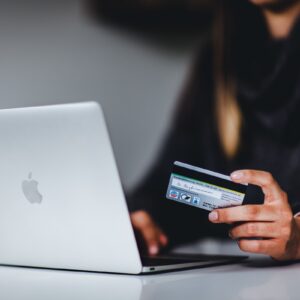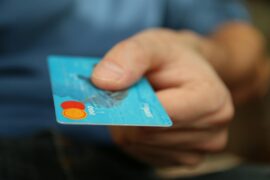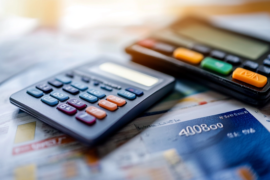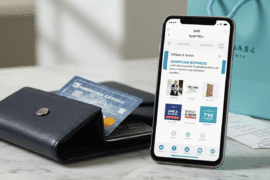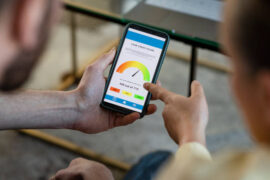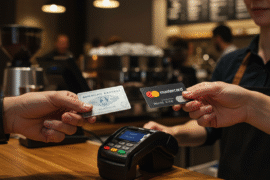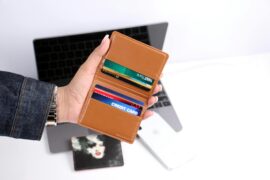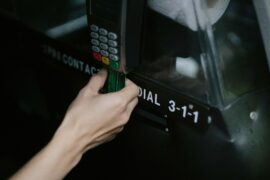This article may contain references to products or services from one or more of our advertisers or partners. We may receive compensation when you click on links to those products or services. Nonetheless, our opinions are our own.
You may use your credit card multiple times a day. When you insert or swipe a credit card at an ATM, retail store, or restaurant, you have to be careful about card skimming.
You should do a quick visual or physical inspection to check for skimmers installed on the card reader. Paying attention to this matter can prevent you from fraudulent transactions. So, make sure to think twice before swiping your card at a point-of-sale terminal at an ATM, gas station, store, etc.
Credit Card Fraud Statistics reveal there were 650,572 cases of identity theft reported in the U.S in 2019. 41% of these were particularly card fraud.
What is a Credit Card Skimmer?
Credit card skimmers are small and illegal devices installed on top of actual card readers. These purposefully designed devices match the original card reader and help thieves to collect your credit card numbers. It makes it difficult for you to realize that you are inserting your card into a skimmer unless you become the victim of theft and fraud.
Some skimmers may be attached to the machine physically and extend the card slot to capture information as you put your card inside. Moreover, some criminals install hidden cameras unlawfully to get access to your PIN or zip code and take away all your money.
Some may also install fake keypads over the real keypads and use Bluetooth and cell phone technology to recover information from skimming devices. More importantly, thieves now use “Card Shimming” devices – paper-thin strips concealed inside the card slot that can duplicate the magnetic stripe on your card. Skimmers are available in different shapes and sizes with varying degrees of complexity.
What are Credit Card ‘Shimmers’?
Credit card thieves have updated their technique with a new tool to access your credit card details easily. Deep insert skimmers are devices inside a payment device; they are the digital version of the credit card skimmers. They are tiny, and you cannot locate them from the outside. When you slide your card into the machine, the shimmer reads data from the chip of your card in the same way as the skimmer reads data on your card’s magstripe.
How Credit Card Skimmers Work
When you slide your card into the ATM, the device can read the magnetic stripe on your credit/debit card. The skimmer can store your card number, cardholder’s name, and expiration date. According to FraudWatch International, an internet security organization that specializes in online fraud and phishing, internet or over-the-phone purchases are a card, not present fraud. Moreover, it explains that criminals can set up accounts in your name to take loans.
Plus, in the case of skimming, your identification number is at risk if you purchase with a debit card. Thieves can get access to it by placing a phony keypad over the actual keypad to note the PIN or installing a pinhole camera to capture you while you enter the PIN.
When you make a transaction through a credit card, it may seem like usual. Still, a card skimmer steals/reads the data of your card magnetic strip, which can be helpful for scammers to carry on fraudulent transactions.
Some skimmers use Bluetooth communication devices from nearly 100 yards away and remotely access data from the card skimmer. Transactions made with a skimming card look as accurate as the actual transaction. It can be rather tricky for banks and credit card companies to notice if the money transaction is genuine. If your bank offers fraud detection or fraud alerts, it will be a great deal to ensure protection to an extent.
How to Spot a Credit Card Skimmer?
It was relatively easy to spot credit card skimmers in the past days because they looked prominent when positioned over the customary point-of-sale terminal. As technology continues to evolve, card skimmers have also learned new ways to steal credit card information and take your money away. Sometimes, it is next to impossible to detect a well-placed card skimmer.
It would help if you considered getting details about identifying card skimmers to protect yourself from fraud and scams. Here are few prominent signs that you can look at to avoid skimming.
- If your card reader seems to be excessively large or loose, you need to check it. If you find it even a bit bulkier, you need to move to another station or ATM. It is a clear sign that something is fishy.
- At the same time, if you find a security seal on a gas pump broken or the pin-pad looks thicker or harder to press, it indicates something is wrong. Beware of the hidden cameras. High-tech data robbers use highly advanced and tiny cameras to get card information that you type in the PIN pad.
- Keep a close eye on the little pinhole camera or phony screens shades positioned above the screen display. It is better to hide your PIN with your hand if you are using a PIN pad for more safety.
- Another best way to catch these skimmers is to look at what the original machine looks like closely. If you notice something unusual in the device, do not use it to make a purchase, you can switch to another point-of-sale terminal.
- Another sign shows that the colors on the card reader and the receipt printers do not match.
- You can fall prey to skimmers on ATMs, gas pumps, parking areas, ticket kiosks, grocery store points of sale, and more. So, it would help if you remain cautious in different ways where card skimmers can target you.
Safety Tips to Protect Yourself
Here are the practical safety tips to protect you from the trouble and stress caused due to card skimmer.
- To avoid a credit card skimmer, you can pay with cash. It will also save your money by getting discounts on paying with cash from some authorized places.
- You can prefer to pay, where the credit card terminal is less likely to interfere. Another safety approach is to use mobile options like Apple Pay, Google Pay, etc.
- Make sure to use credit instead of debit cards. Using a debit card has more risks because if a criminal gets access to your debit card information, they can easily access your bank account.
- First, look at the card reader closely to make sure you find nothing unusual. In case of feeling something wrong, immediately report to the concerned authorities.
- Moreover, you can prefer to stay at the terminal, ATM, or station in a well-lit and well-maintained place. Besides, you can set up alerts to watch the activity on your credit and debit card.
- Importantly, you can download the skimmer scanner app that can give you warning signs about the skimmer. The app will alert you through Bluetooth if the machine has any card skimmer attached.
- One of the best ways to prevent card skimming is to use a card with a chip. Skimming devices work with the support of a magnetic strip. You can use a card with an EMV chip or simple chip to ensure maximum protection.
- EMV chips work through a process called “tokenization” that protects your card information. It avoids transferring your actual card data during the transaction. Instead, it generates a one-time token that works as a placeholder keeping the existing data saved on a secure server. It means that if someone tries to steal your card, the token will be worthless for them.
- Shimmers are the newest tool that could read data from the chip-based debit or credit card to an extent. The smallest shimmers inserted into card readers can reveal information from the chips on newer cards. So be vigilant!
What Should I do in case of Card Skimming?
Credit card issuers claim that they use fraud detection technology. Still, they cannot ensure maximum protection. You may also not notice that your card has skimmed unless you observe fraudulent transactions on your account.
Here is what you can do in case of card skimming.
- If you notice card fraud, immediately contact the card issuer to block card access. This way, you will not be responsible for paying back the funds to the issuer in case of fraud.
- Alert the particular source where you believe that card skimming took place so the authoritative person can help you prevent any other theft.
- Moreover, you can contact your local law enforcement agency and the consumer division of your state attorney general’s office.
- In case of significant financial loss, you can contact Federal Trade Commission.
- Once the deceitful action takes place with your credit card, it may not be possible to fix it. However, contacting higher authorities could prevent further skimming and prevent someone else from being skimmed.
Final Thoughts
Keep in check your transaction history frequently. If your card gets skimmed, it will be easy to avoid inconvenience and loss for the next time. You need to report the fraudulent activity within 60 days of skimming. So keep an open eye on skimming devices to avoid stressful situations and fraudulent transactions.

Reviewed and edited by Albert Fang.
See a typo or want to suggest an edit/revision to the content? Use the contact us form to provide feedback.
At FangWallet, we value editorial integrity and open collaboration in curating quality content for readers to enjoy. Much appreciated for the assist.
Did you like our article and find it insightful? We encourage sharing the article link with family and friends to benefit as well - better yet, sharing on social media. Thank you for the support! 🍉
Article Title: How to Spot a Credit Card Skimmer
https://fangwallet.com/2021/09/22/how-to-spot-a-credit-card-skimmer/The FangWallet Promise
FangWallet is an editorially independent resource - founded on breaking down challenging financial concepts for anyone to understand since 2014. While we adhere to editorial integrity, note that this post may contain references to products from our partners.
The FangWallet promise is always to have your best interest in mind and be transparent and honest about the financial picture.
Become an Insider

Subscribe to get a free daily budget planner printable to help get your money on track!
Make passive money the right way. No spam.
Editorial Disclaimer: The editorial content on this page is not provided by any of the companies mentioned. The opinions expressed here are the author's alone.
The content of this website is for informational purposes only and does not represent investment advice, or an offer or solicitation to buy or sell any security, investment, or product. Investors are encouraged to do their own due diligence, and, if necessary, consult professional advising before making any investment decisions. Investing involves a high degree of risk, and financial losses may occur including the potential loss of principal.
Source Citation References:
+ Inspo


